I tried and tried, many times, to make a healthy, whole oven “fried” chicken.
And I always came up short in the past, mainly because the chicken tasted too bland and dry after baking.
Until, I think, I finally got it right in this recipe.
Along with adding some yummy herbs and spices to the breading (like ground sage and paprika), I finally discovered The Really Major Key to making oven baked chicken taste delicious…
…which is adding a layer of Honey-Dijon under the breading.
It keeps the chicken really tender but also adds a lot of tangy-sweet flavor.
This chicken is also really easy to throw together, and you’re free to whip up some sides (mashed potatoes and sweet corn, anyone?) while it bakes away in the oven.
(For the complete, printable recipe, scroll down to the bottom of the page.)
Here are the ingredients you’ll need to make your oven “fried” chicken.
Begin by preheating the oven to 450 degrees F.
Then grab a nice big casserole dish and add some whole wheat bread crumbs, garlic powder, dried thyme, ground sage, cumin, and paprika.
And stir it all up.
Here’s a label I’ve been looking for these days when I buy packaged items like the bread crumbs in this recipe: the Non GMO Project label.
I’ve been aware of GMOs for a while (they were introduced to our food supply in the U.S. in the mid-90’s), but I’ve only recently really started to look into the research on genetically engineered foods, also called “genetically modified organisms” (or GMO’s).
What exactly are these “genetically modified organisms” that we’re eating every day?
It sounds complicated (it is very complicated) but, it’s actually really simple to sum up and understand the basic concepts:
1) Big chemical corporations either insert a pesticide protein into the crop seed (corn, for example) so that the pesticide is now a part of the genetic makeup of the corn we eat (or the “corn syrup,” “cornstarch,” “maltodextrin,” etc., etc. in our packaged foods)
2) or they alter the crops to withstand high levels of herbicides that would – without the genetic engineering – kill the crop (which has, obviously, led to a huge increase in the use of herbicides in our country over the past several years).
All those pesticides and herbicides were enough to make me very wary, but then I learned this: in recent years, the amount of GMOs in our food supply has exploded – GMOs are now in about 75 percent of the foods we eat in the U.S.
How can that be?
Because the three main crops that are genetically modified in our country (corn, soy, and sugar beet) are used in almost every kind of packaged product we buy and every fast food meal we eat (cereals, cooking oils, cookies, crackers, breads, frozen meals, you name it!)
Of course, genetically modified crops aren’t supportive to the natural environment long-term, so how is it possible they’re safe for people to eat?
No one knows if they are safe because independent science can’t even prove what the true long-term health effects may be.
Here’s the deal there:
Because our government allows the chemical corporations who manufacture these genetically modified seeds to patent and “own” the seeds, the chem corps haven’t allowed any truly independent, peer-reviewed scientific studies to happen (these corporations fund their own GMO studies “proving,” of course, the “safety” of their own products, and they could and would sue any scientists who tried to do truly independent research).
Which introduces my biggest question: what may these chemical corporations potentially know and what info may they potentially be hiding, that they so staunchly block independent research?
If you feel concerned, there’s good news – – which brings me back around to the Non GMO Project label.
This is a non-profit third-party organization that verifies and labels packaged foods that don’t contain GMOs. It’s really gaining in popularity and I’ve noticed the label popping up on more and more foods.
So if you’re concerned about eating GMOs or if you want to show your support for companies committed to not using GMOs, look for this label (the ‘USDA Organic’ label on foods also means that the food is non-GMO).
Next up: grab a small bowl, add some Dijon mustard and some honey, and stir it up.
Then grab a couple of large bone-in chicken breast halves.
(Or substitute four small skinless, boneless chicken breasts)
Remove the skin and any visible fat (or your butcher can do this for you when you buy the chicken).
And spread the honey mustard mixture all over the top of each piece of chicken.
Then toss the chicken into the casserole dish, and coat each piece with the bread crumb mixture.
Season the chicken with salt and pepper.
Put the cover on the casserole dish (or wrap some foil over the top of the dish) and let the oven do the work from there!
After about 25 minutes, take the chicken out of the oven and remove the lid or foil.
Drizzle some olive oil over the top of each piece of chicken, then place the dish back in the oven to cook a bit longer, uncovered this time around.
The oil will help the breading turn a toasty, very irresistible-looking, golden-brown.
Serve it up with a couple of tasty sides, and enjoy a scrumptious oven “fried” chicken dinner!
I think you’ll agree – the Honey-Dijon layer under the breading is the secret weapon for tender, richly flavored baked chicken!
Here is the complete, printable recipe:
- Serving size: 4
- Calories: 192
- Fat: 3.3g
- Carbohydrates: 9.6g
- Sugar: 4.1g
- Sodium: 293mg
- Fiber: .8g
- Protein: 28.4g
- Cholesterol: 74mg

Prep: 10 minutes
Cook: 40 minutes
Yield: 4 servings
- 2 large organic bone-in chicken breast halves, skin and fat removed
- 2 tablespoons Dijon mustard
- 2½ teaspoons organic honey
- ½ cup whole wheat Panko bread crumbs (or regular bread crumbs)
- 1 teaspoon garlic powder
- 1 teaspoon dried thyme
- 1 teaspoon ground sage
- 1 teaspoon cumin
- ½ teaspoon paprika
- 1 tablespoon olive oil
- Salt and freshly ground black pepper
- Preheat oven to 450 degrees F.
- In a large casserole dish, add the bread crumbs, garlic powder, thyme, sage, cumin, and paprika. Stir until well combined.
- Add the Dijon and honey to a small bowl and stir until well combined.
- Using a table knife or small spatula, spread the honey mustard mixture all over the top of each piece of chicken.
- Place the chicken in the casserole dish, coating each piece with the breadcrumb mixture. Season the chicken with salt and pepper.
- Cover the casserole dish with foil and bake for about 25 minutes.
- Remove from the oven and discard the foil. Drizzle some olive oil over the top of each piece of chicken, then place back in the oven, uncovered.
- Cook about 15 minutes more, or until the chicken is cooked through and the breading is toasted and golden. Serve.
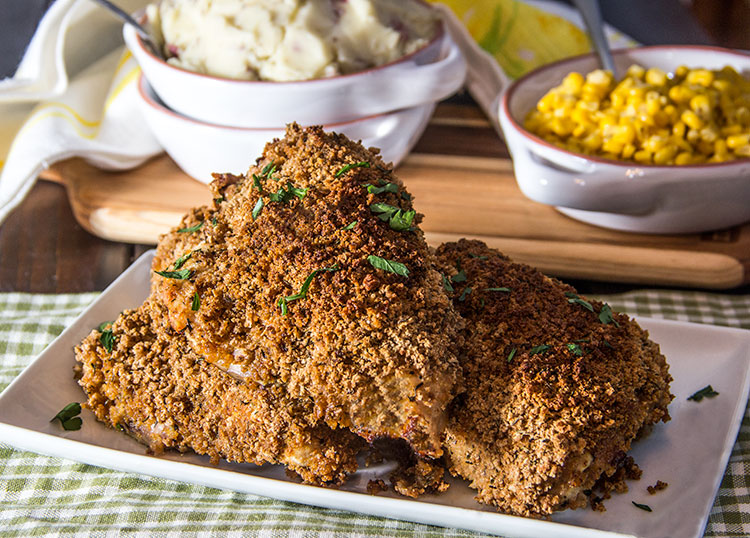
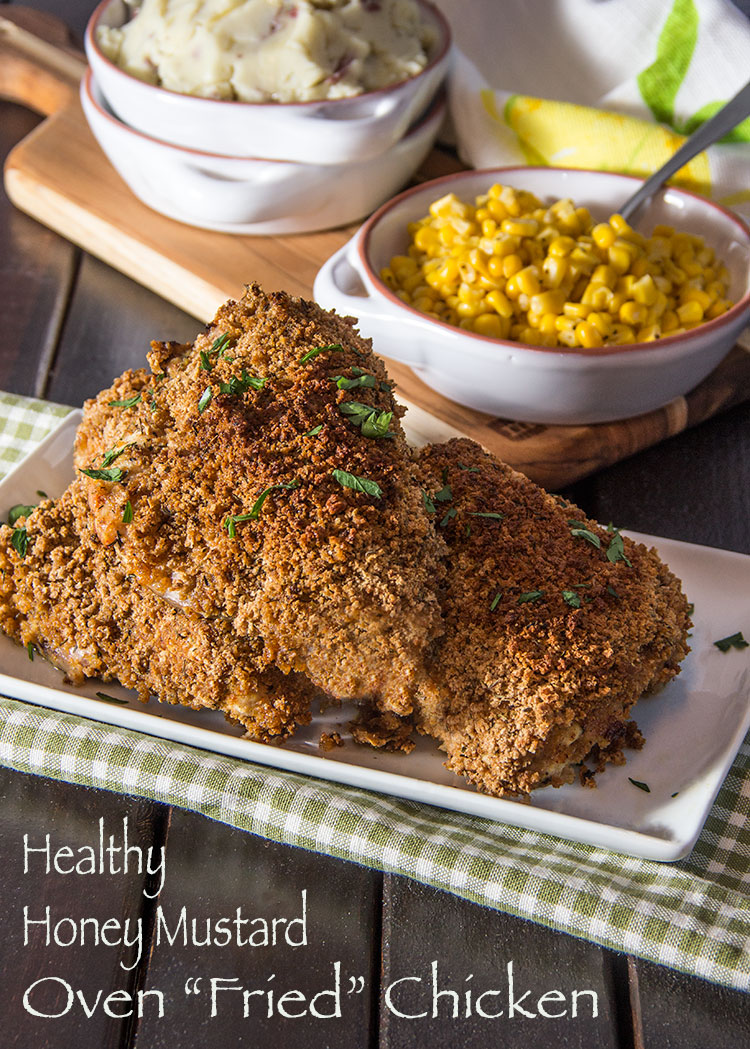
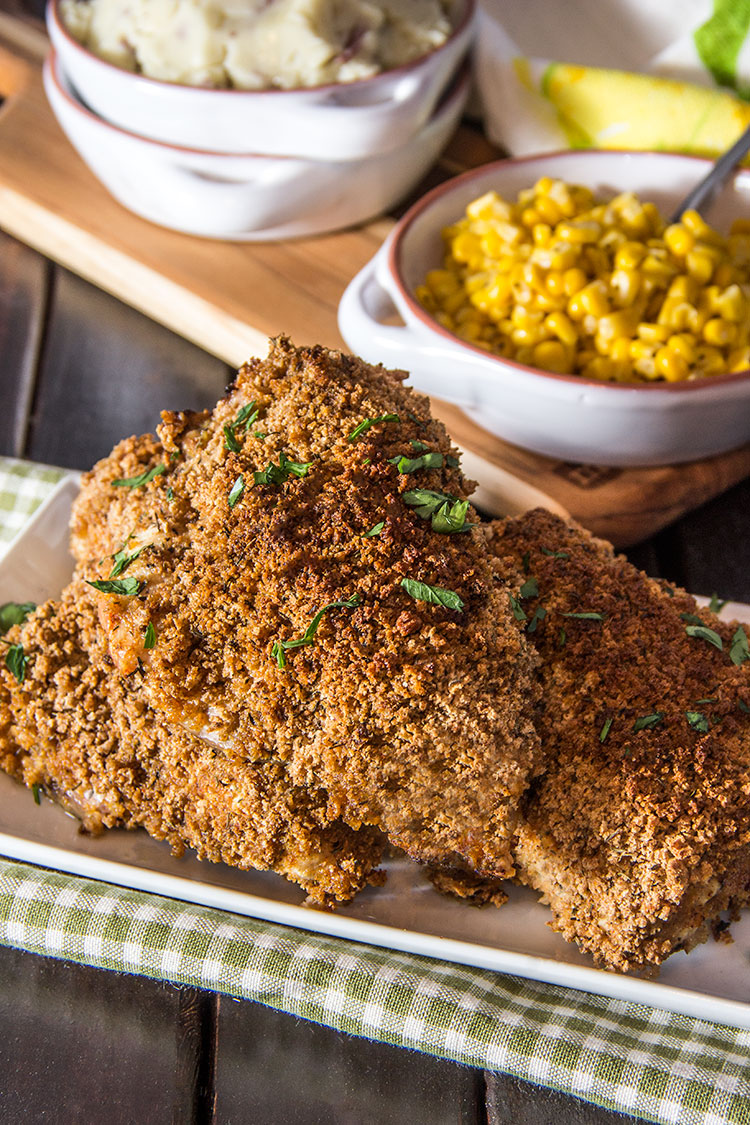



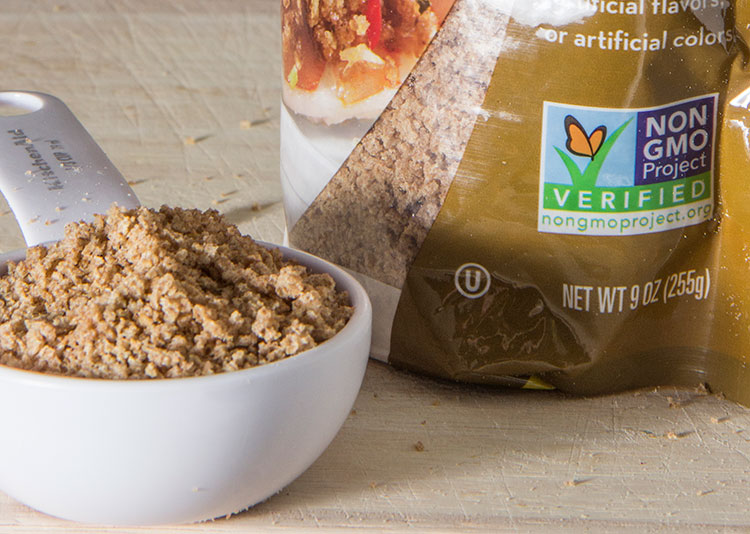


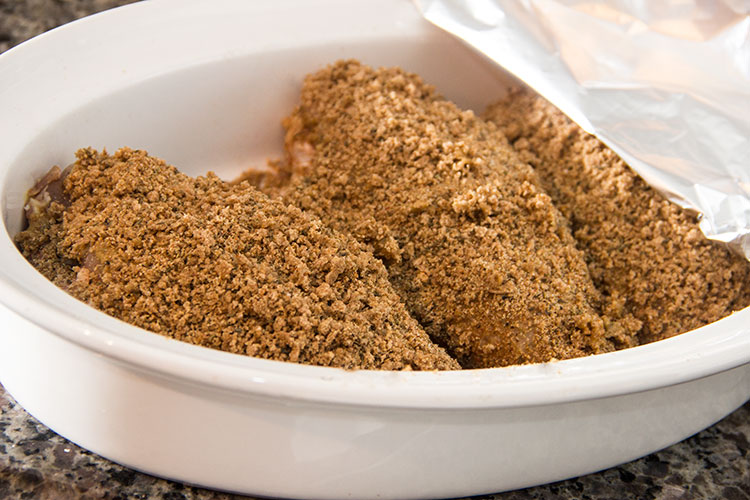
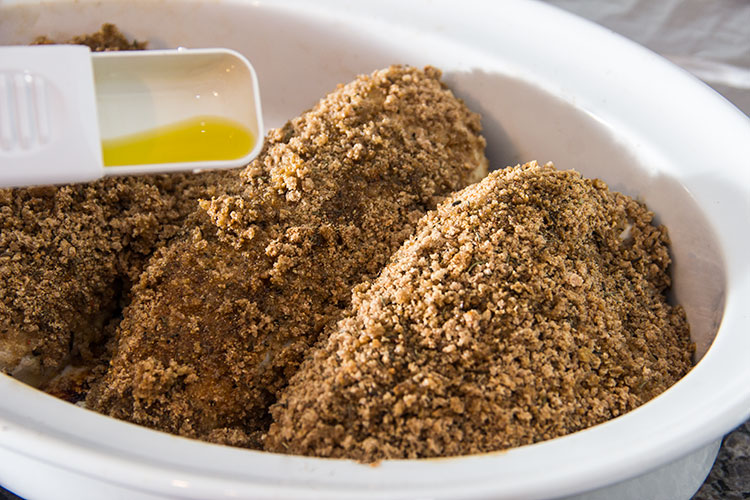
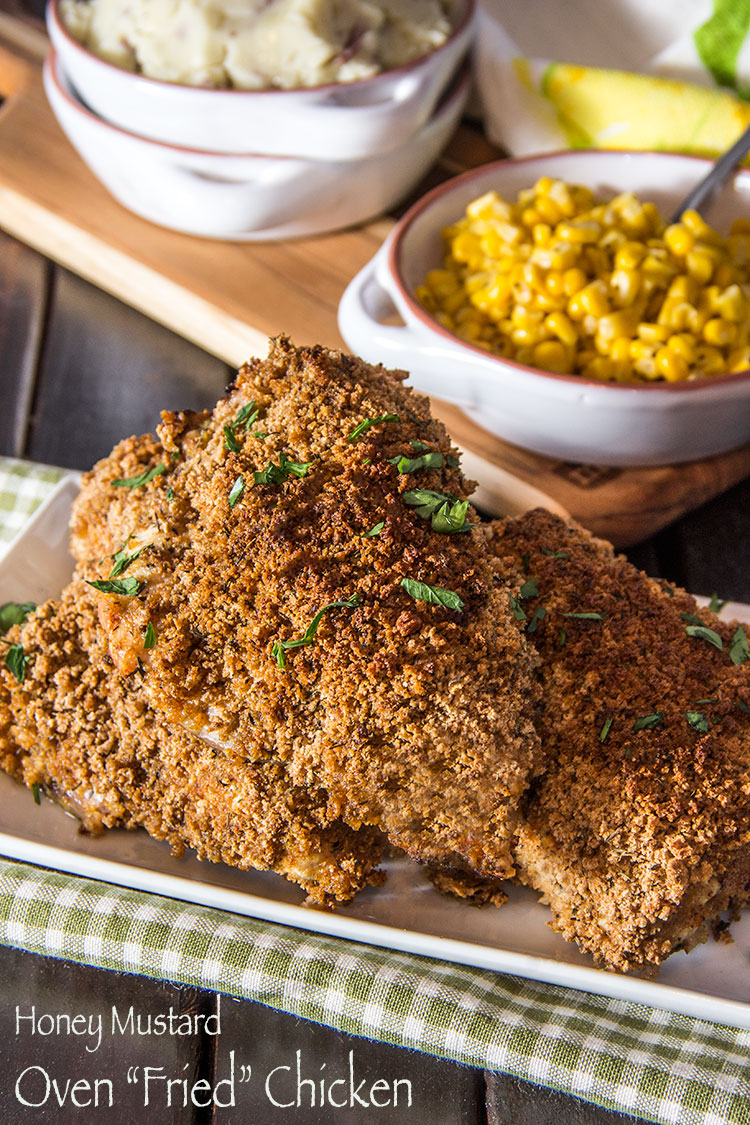
This chicken looks good enough to be from a gourmet chicken shop, it looks so delicious!
Honey and mustard must flavour perfectly!
Cheers
Choc Chip Uru
Hi Jen, these look fantastic. Super crispy, but I’ve also wanted a “fried chicken” dish to go in the oven. Would it help to brine or marinate in buttermilk to give it a little extra helping hand?
Dave
Honey mustard chicken was always one of my old standby dishes but I never tried breading it as well. I must try it sometime 🙂
I never thought oven-fried chicken could looks so gorgeous and flavorful! Lovely photos. Great recipe. I hope to try this out dish very soon.
Yeah, I’m never reading this site again. I came here for recipes, not your ridiculous misinformation about GMO crops.
NEWSFLASH: GMO crops have sustained and fed more than a billion people worldwide. It’s not just corn, soy, and sugar beet, it’s wheat, rice, cassava, potatoes, beans, bananas and numerous other things that have been altered to withstand specific environments, diseases and climates. If you’re privileged enough NOT to eat any of that, good for you – but to say that GMO is BAD when needy people rely on it for basic nutrition, is so ignorant and reeks of First World privilege. Organic costs so much because it yields less and is expensive to produce – people in North America can barely afford it.
Study after study has shown that GMO food is fine for human consumption. Like the microwave oven myths, certain people who poorly understand the basic concepts of the situation won’t stop publishing ridiculous myths. That entire website you linked is biased as can be: check the credentials of the scientists involved. Michael Antoniou, for example, has a history of questionable research tactics, and his methodology has been criticized, if not refuted, numerous times. We have been manipulating the genes of crops for hundreds of years, from a scientist doing it with a machine over a few months to a monk doing it by hand over several decades.
You wanna criticize the industry, then do so where there’s truth: how Monsanto copyrights strains of corn and legally attacks farmers who end up with that strain, even if it’s by accident; the possibility of loss of bio-diversity; the use of ethical farming practices so your precious organic produce isn’t picked by migrant workers working in slave-like conditions. Be responsible, and educate yourself.
Thank you very much for pointing out several of the other major injustices with GMOs, and I do absolutely agree with you there.
I’m glad you’ve pointed them out so that they’re here along with this post.
I used to believe that GMOs might possibly be the next logical step forward in terms of our world food supply.
But I’ve become interested in the topic, and my research into the issue has led to some big questions:
I absolutely do understand why you might think of organic foods as a “privilege.” After all, organic foods are more expensive in American grocery stores.
But should organic be considered a privilege? Organic farming was the only choice for farming for thousands of years. Organic farming just means growing foods without the use of unnatural chemicals (pesticides and herbicides) that are often very damaging to the environment. In most summer climates, anyone with access to a patch of land that receives lots of sunlight could grow an organic vegetable garden, if they chose to.
Why are organic foods so expensive in the U.S. then? There are many reasons, but most of them have to do with our government and financial systems, which don’t currently support organic farming (and that’s something we could change, if we choose to!) For example: government subsidies. Subsidies are funds that come from American taxpayers and support farming operations to help make our food affordable – the more subsidies a farm receives, the more affordable the food becomes. Unfortunately, the majority of our subsidies go to big commercial operations (GMO monocultures where one crop is grown year after year over a vast area) and almost nothing goes to smaller-scale organic farming operations. For example, in 2008 the House Appropriations Committee spending on farm subsidies came up to $7.5 billion, but only $15 million of that was given to organic and local food programs combined (that’s roughly .2% of the total funds!).
One really big eye-opener for me was when I started looking into the research on organic vs. GMO and conventional farming (monocultures where one crop is grown year after year over a vast area with the help of pesticides and herbicides). This study done by the United Nations was jaw-dropping for me, as it demonstrates how conventional and GM farming is responsible for about 44 percent of greenhouse gas emissions! I wrongly believed climate change was all caused by driving and heating our homes, etc. Who knew half the problem could be solved just from switching from GMO/conventional farming to organic?
Soil erosion is another huge issue with conventional and GMO farming. While organic farming supports resilient, healthy soil, the opposite is true for GMO and conventional farming. Pesticides and monocultures erode and degrade soil. As we experience more severe weather due to climate change (like the huge recent drought in California) we’ll desperately need resilient, healthy soil.
This seems to be especially true in many developing world climates. Here is another study done by the United Nations, which details how organic farming helps support food security in Africa.
In addition to climate change and soil erosion, synthetic pesticides and herbicides have also been linked to a host of other problems in the natural environment, for example colony collapse disorder (honey bee colonies are dying off in huge numbers, a huge problem since we’re completely dependent upon them for pollinating our crops).
There was another 30-year study which found that, over time, organic farms result in better yields and far less energy and pollution expenditures (plus higher quality and more fertile soil). Even the USDA has issued a study which confirms that GMOs do not lead to higher yields long-term.
If GMO crops aren’t even leading to higher yields over the long-term, and they’re contributing to 44 percent of our greenhouse gas emissions and they’re polluting our drinking water and they’re degrading our soil and they’re damaging wildlife we depend upon for pollination, my question is: why are we moving in the direction of developing more and more GMO crops?
Despite all of the benefits of organic gardening, many argue that GMOs should be our next step in addressing the problem of hunger in the developing world. But I’m not convinced that our current technology surrounding GMOs is sufficient to solve the problem. Mainly because GMOs do not address any of the underlying problems / root causes (political and financial systems) that lead to hunger in developing nations. (i.e. it’s like trying to apply a band-aid to stop a gushing wound). If GMOs don’t address the fundamental issues, they can’t solve the problem of world hunger and may make things worse long-term.
Here is one concern. The Green Revolution, which happened around the 1960’s, is an example of how we may repeat some past mistakes with the development in GMOs. What happened with the Green Revolution: we introduced conventional farming (monocultures of one crop grown over a large expanse of land, year after year, along with the use of pesticides and herbicides) to developing country farmers as a tool to help them produce more food. Unfortuneatly, people were not adequately educated in how to safely use these dangerous chemicals. They were also not provided with the safety equipment they needed to handle these toxic substances. This resulted in pesticide poisonings and cancer due to long-term exposure of these chemicals, as well as contamination of drinking water supplies. In addition, farmers developed a new dependence upon corporations for pesticides and herbicides, and found themselves indebted to these corporations. Another result was major degradation to the soil and increases in pests, because monocultures do not support the natural environment.
The same things may happen again, maybe to an even greater degree of severity, with GMOs. Take the example of Golden Rice, which is rice genetically engineered to contain Vitamin A and currently in testing phases. Big chemical corporations (like Syngenta and Monsanto) have made the most of this PR opportunity by offering to hand out patents of these seeds for free to farmers in the developing world.
But there are questions. Just like in the Green Revolution, this leads to farmers becoming completely dependent upon the big multinationals for patented seeds and chemical pesticides. And, although Golden Rice may provide some additional Vitamin A, it does not solve the really big underlying issue, which is that people aren’t getting enough of a wide variety of vitamins and nutrients due to a lack of biodiversity in food crops.
And what happens when these biotech corporations move their focus to the next big PR scheme, as they inevitably will in an ever-changing world? The Golden Rice patent handouts will likely become increasingly more difficult to come by. And then what for farmers? It’s the Green Revolution all over again: farmers have fundamentally destroyed their soil and their natural environment by creating vast monocultures of Golden Rice. They are also now dependent upon rice also as a source of Vitamin A, as they’ve not been taught how to grow a variety of crops that naturally contain these nutrients. That also makes them dependent upon the giant corporations that own these seeds.
This documentary, which interviewed many farmers from developing countries all over the world, was really eye-opening for me. It features interviews with many people in various developing nations who explain their difficulties in dealing with the big biotechs while also trying to grow their food.
After going through all this information I started to ask: imagine if the millions of dollars poured into technologies like Golden Rice research had gone instead to providing farmers of developing countries with the equipment and irrigation systems needed for organic farming. What if the decades spent on lab-produced GE seed research went instead into educating farmers about crop rotation, soil quality, and natural pest control. What if, instead of handing out laboratory-produced and corporate-owned seed and dangerous herbicides and pesticides, we had provided them with the tools and taught them best practices to grow the organic gardens that support their natural environment? What if we had focused more on teaching tools that could feed people year after year (as opposed to corporate-owned and patented seed handouts that are useful for a couple of seasons before the soil becomes degraded)?
There was one other question I had to ask too. A GMO and a hybrid plant are two separate terms with different definitions. The hybridization processes that have been used by people for a couple of hundred years involve cross breeding plants (and even hybrids do have their disadvantages, such as loss of local natural species that may have developed defenses against local pest and weather patterns) GMOs on the other hand, were introduced into our American food supply in the mid-90s and involve inserting DNA from one organism into another. Genetic engineering is a part of a process called horizontal gene transfer, and it’s the main cause of antibiotic resistance, a major concern to health-care providers today. GMOs eventually grow in farmer’s fields, however, they always begin as man-made seeds that must be manufactured in a laboratory. Horizontal gene transfer doesn’t happen in nature, because organisms have many built-in defenses to prevent it from happening.
So my question became: do man-made, unnatural, corporate-owned and biotech-patented seeds truly represent the very best we can do in terms of moving forward with our world food supply?
The topic is incredibly complex, but in the end, my thinking came down to this belief: organic farming supports the natural environment rather than destroys it. And every time we destroy the natural environment, we end up hurting ourselves, because we’re all part of one interconnected system of life on the planet. That’s why, in the end, I’ve made the decision to support organic farming by buying organic foods.
This looks delicious! I too have not had the best luck with oven fried chicken, I need to give this a try.
I like the idea of the honey mustard under the breadcrumbs. Your chicken looks crisp and delicious.